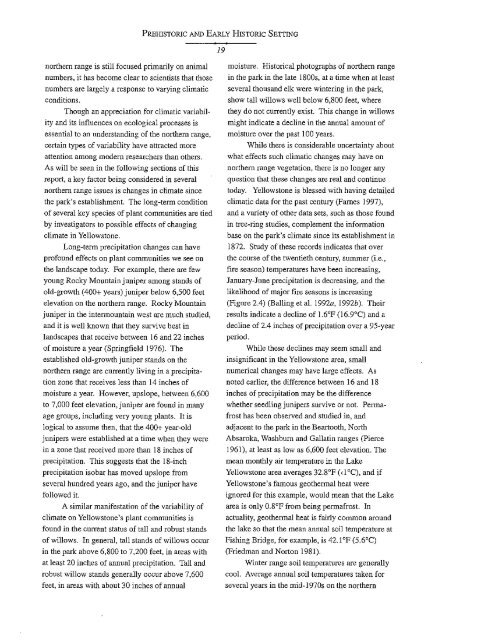Yellowstone's Northern Range - Greater Yellowstone Science ...
Yellowstone's Northern Range - Greater Yellowstone Science ...
Yellowstone's Northern Range - Greater Yellowstone Science ...
Create successful ePaper yourself
Turn your PDF publications into a flip-book with our unique Google optimized e-Paper software.
PREHISTORIC AND EARLY HISTORIC SETTING<br />
19<br />
northern range is still focused primarily on animal<br />
numbers, it has become clear to scientists that those<br />
numbers are largely a response to varying climatic<br />
conditions.<br />
Though an appreciation for climatic variability<br />
and its influences on ecological processes is<br />
essential to an understanding of the northern range,<br />
certain types of variability have attracted more<br />
attention among modern researchers than others.<br />
As will be seen in the following sections of this<br />
report, a key factor being considered in several<br />
northern range issues is changes in climate since<br />
the park's establishment. The long-term condition<br />
of several key species of plant communities are tied<br />
by investigators to possible effects of changing<br />
climate in <strong>Yellowstone</strong>.<br />
Long-term precipitation changes can have<br />
profound effects on plant communities we see on<br />
the landscape today. For example, there are few<br />
young Rocky Mountain juniper among stands of<br />
old-growth (400+ years) juniper below 6,500 feet<br />
elevation on the northern range. Rocky Mountain<br />
juniper in the intermountain west are much studied,<br />
and it is well known that they survive best in<br />
landscapes that receive between 16 and 22 inches<br />
of moisture a year (Springfield 1976). The<br />
established old-growth juniper stands on the<br />
northern range are currently living in a precipitation<br />
zone that receives less than 14 inches of<br />
moisture a year. However, upslope, between 6,600<br />
to 7,000 feet elevation, juniper are found in many<br />
age groups, including very young plants. It is<br />
logical to assume then, that the 400+ year-old<br />
junipers were established at a time when they were<br />
in a zone that received more than 18 inches of<br />
precipitation. This suggests that the IS-inch<br />
precipitation isobar has moved upslope from<br />
several hundred years ago, and the juniper have<br />
followed it.<br />
A similar manifestation of the variability of<br />
climate on <strong><strong>Yellowstone</strong>'s</strong> plant communities is<br />
found in the current status of tall and robust stands<br />
of willows. In general, tall stands of willows occur<br />
in the park above 6,SOO to 7,200 feet, in areas with<br />
at least 20 inches of annual precipitation. Tall and<br />
robust willow stands generally occur above 7,600<br />
feet, in areas with about 30 inches of annual<br />
moisture. Historical photographs of northern range<br />
in the park in the late ISOOs, at a time when at least<br />
several thousand elk were wintering in the park,<br />
show tall willows well below 6,SOO feet, where<br />
they do not currently exist. This change in willows<br />
might indicate a decline in the annual amount of<br />
moisture over the past 100 years.<br />
While there is considerable uncertainty about<br />
what effects such climatic changes may have on<br />
northern range vegetation, there is no longer any<br />
question that these changes are real and continue<br />
today. <strong>Yellowstone</strong> is blessed with having detailed<br />
climatic data for the past century (Farnes 1997),<br />
and a variety of other data sets, such as those found<br />
in tree-ring studies, complement the information<br />
base on the park's climate since its establishment in<br />
IS72. Study of these records indicates that over<br />
the course of the twentieth century, summer (I.e.,<br />
fire season) temperatures have been increasing,<br />
January-June precipitation is decreasing, and the<br />
likelihood of major fire seasons is increasing<br />
(Figure 2.4) (Balling et al. 1992a, 1992b). Their<br />
results indicate a decline of 1.6'F (16.9'C) and a<br />
decline of 2.4 inches of precipitation over a 95-year<br />
period.<br />
While these declines may seem small and<br />
insignificant in the <strong>Yellowstone</strong> area, small<br />
numerical changes may have large effects. As<br />
noted earlier, the difference between 16 and IS<br />
inches of precipitation may be the difference<br />
whether seedling junipers survive or not. Permafrost<br />
has been observed and studied in, and<br />
adjacent to the park in the Beartooth, North<br />
Absaroka, Washburn and Gallatin ranges (Pierce<br />
1961), at least as low as 6,600 feet elevation. The<br />
mean monthly air temperature in the Lake<br />
<strong>Yellowstone</strong> area averages 32.S'F «1 'C), and if<br />
<strong><strong>Yellowstone</strong>'s</strong> famous geothermal heat were<br />
ignored for this example, would mean that the Lake<br />
area is only 0.8'F from being pennafrost. In<br />
actuality, geothermal heat is fairly common around<br />
the lake so that the mean annual soil temperature at<br />
Fishing Bridge, for example, is 42.1°F (5.6°C)<br />
(Friedman and Norton 1981).<br />
Winter range soil temperatures are generally<br />
cool. Average annual soil temperatures taken for<br />
several years in the mid-1970s on the northern















